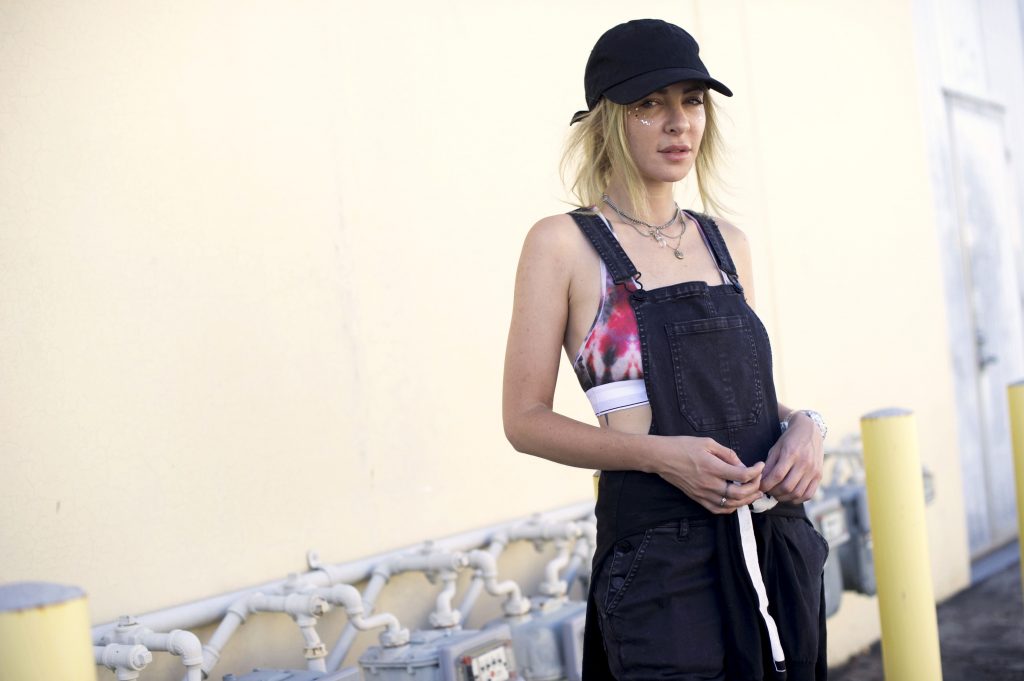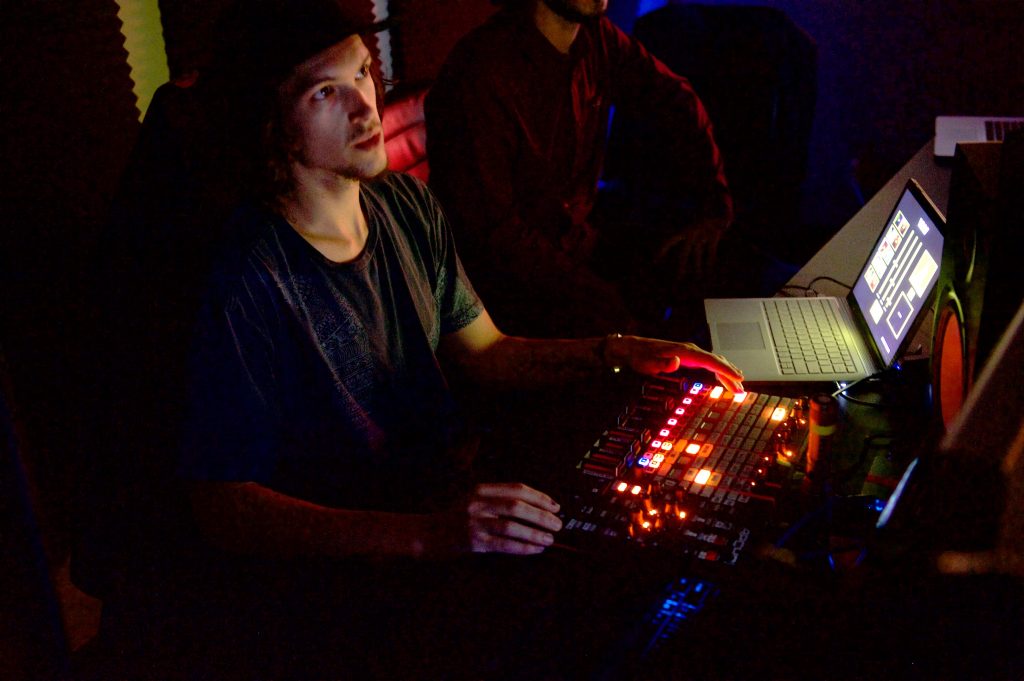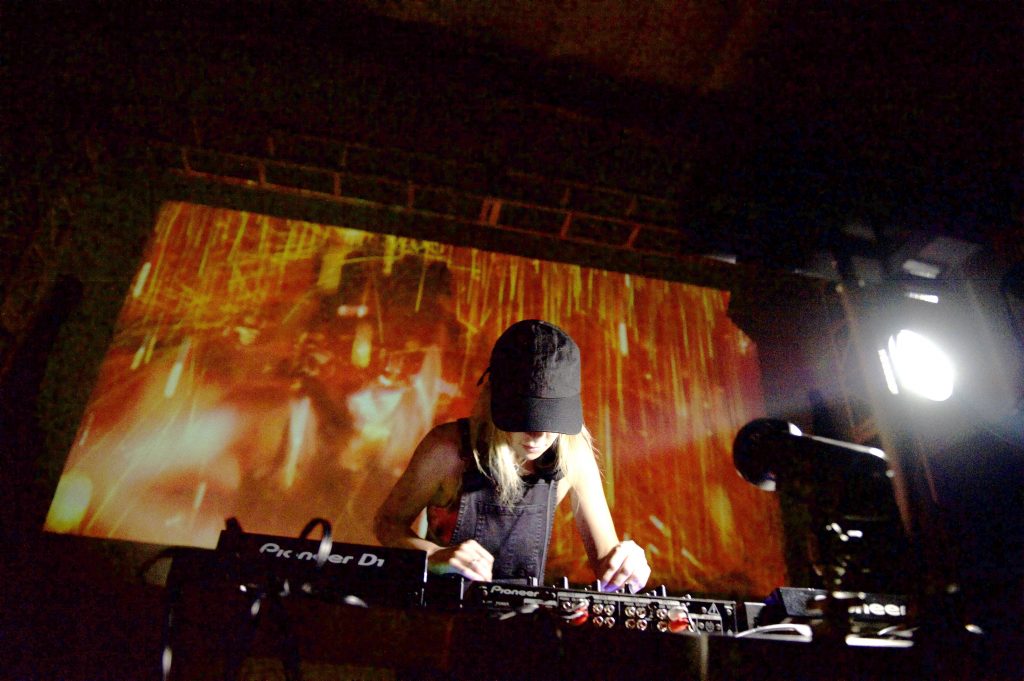
From local venues to major festivals, Surface-powered kit takes electronic artist Alison Wonderland’s live act to a new level
DJ and producer Alison Wonderland was so caught up in what she was doing during a recent rehearsal for her upcoming tour that when she turned around and looked at the screen displaying her image, she did a double take.
Her silhouette was a ball of fire, flames coming from her hands as they moved. Then she was a sheet of rain, lines of liquid flowing down her body and droplets bouncing from her. Wonderland, whose live shows are kinetic spectacles of flash and fire, was amazed.
“I got so caught up in the visuals and how they followed my movements that I forgot what reality I was in for a second,” says Wonderland, whose real name is Alex Sholler. “It really elevated the music I was playing, but it didn’t take away from the performance. It’s so cool.”
The effects were created by a custom performance kit Microsoft developed in collaboration with Wonderland to provide a compact, user-friendly solution geared for touring. The kit is powered by a Surface laptop; using the Surface’s touch screen, Wonderland’s visual designer can add effects to Kinect-captured images, making Wonderland look like she’s swirling in a tornado or equipped with giant red wings.
The project came about as Microsoft was looking to create an interactive tool to give electronic artists like Wonderland greater control over their onstage visuals, says Amy Sorokas, director of Brand Studios for Microsoft. Traditionally, a DJ plays music while someone else runs the visuals, but the two aspects of the show often aren’t entirely integrated, Sorokas says. Wonderland was developing a new stage show for her summer tour, and her use of technology and dynamic performing style made her an ideal artist to collaborate with, according to Sorokas.
“She’s interested in what technology can do, and she’s also very interested in what her visuals look like, what the story is around those, and how it all comes to life,” says Sorokas. “She has a strong visual identity. So being able to bring those elements together was a really great natural fit.”
I love it because it provides avenues for creativity that aren’t possible with other technology.
Wonderland gave the creative team references for imagery that resonated with her — fire, water, candles, stained glass. Her songwriting touches on subjects such as suicide and addiction, and Wonderland wanted the visuals to reflect that darker side. A “massive fantasy nerd,” she also wanted an aesthetic that evoked a sense of mysticism. Most importantly, she wanted to create a connection with audiences.
“When I play a show, I need to feel the energy from the crowd,” says Wonderland, who recently moved from her native Sydney, Australia, to Los Angeles. “You go to a music festival and people are tied up in their phones or worried about what they look like when they’re dancing. I just want people not to care and let go for an hour.
“Not everyone’s going to like the music, but I still want people to have an experience, and I feel like what Microsoft is doing with the visuals helps centralize where the crowd’s focus is.”
To bring Wonderland’s vision to life, her management team worked with Microsoft and a crew of creative developers and designers. The team created 10 effects, or “visual scenes,” that can be imposed on images captured by two Kinect cameras — one focused on Wonderland’s head and shoulders and the other capturing her outline from behind.

Russ Rive, the project’s creative director, said the goal was to create an application that can be used alone or easily integrated into the software used by Wonderland’s visual designer, Alex Vicente. The application will allow Vicente to change the effects’ colors and control their intensity and how sensitive they are to the music — all through the Surface’s touch screen.
“We spent a lot of time thinking, ‘How can we make this interface be as easy and fun to use and least intimidating as possible?’” Rive says. “We treated it as if it’s just an extra input channel into their existing system. It gives them total flexibility and access to these really cool visuals that have been created through the Surface Book. Literally, within the first half-hour of us getting it set up and running, there were smiles everywhere. Everyone was really excited.”
Rive says the team initially thought they would use the Surface as the application interface and need another high-powered computer to process the visuals. To their surprise, the Surface could do it all.
“It’s really impressive what that little laptop can do. It’s a bit of black magic,” Rive says, adding with a laugh, “There’s a lot of geek envy of Surface on our team now.”

The Microsoft Surface kit will debut at Wonderland’s Aug. 5 show in Chicago. Vicente says the kit will enable him to do more than he could with traditional camera-generated effects, which were limited mainly to distorting Wonderland’s outline or adding colors.
“Instead of just altering her form, we’re completely transforming her,” he says. “That’s really the selling point — the capability to still have her form and her interaction to connect with the audience, but taking it to the next level visually. I love it because it provides avenues for creativity that aren’t possible with other technology.”
Wonderland has been a rising star on the electronic music scene since releasing her debut Album, “Run,” in 2015. The album went gold in Australia and debuted at number 1 on the U.S. Billboard electronic charts. She has since played high-profile venues and festivals, including Coachella, Lollapalooza, Tomorrowland and the Electric Daisy Carnival (EDC) in Las Vegas, one of the biggest dance music festivals in the world.
Trained as a classical musician, Wonderland was a principal cellist in the Sydney Youth Orchestra but eventually found orchestral performance “too sterile” and constricting. She left the orchestra and played bass in a punk bank, then started DJing and taught herself to produce music on a computer.
“It organically happened. I found my way,” she says. “I never thought I was going to make a career out of this. Now I’m here, and I’m so happy.”
Lead photo: DJ and producer Alison Wonderland














